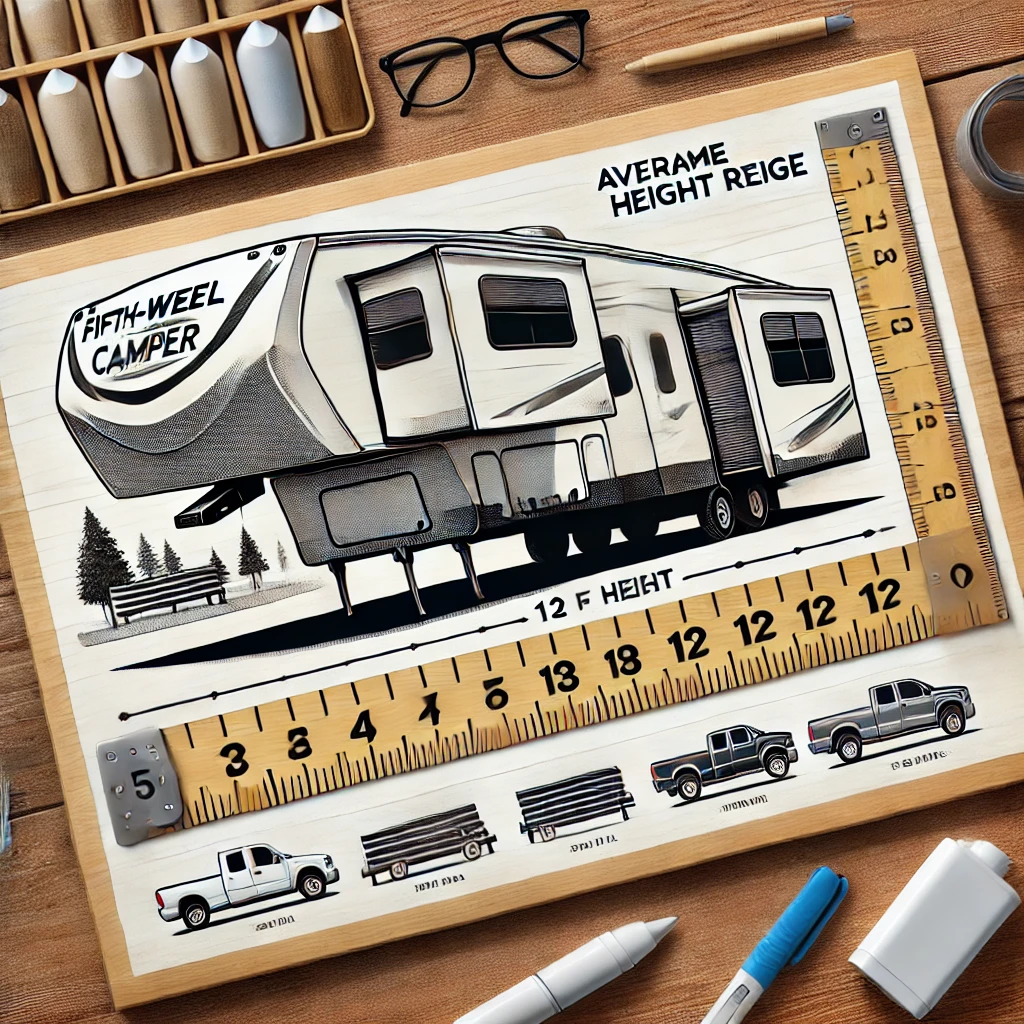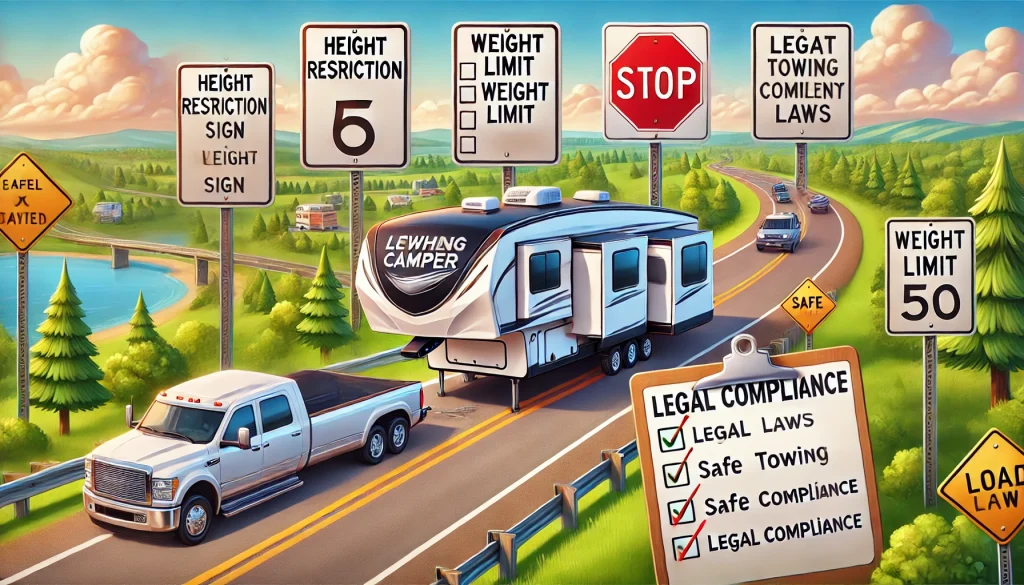Fifth-wheel campers are popular for their spacious interiors and luxurious features, but their height is an important consideration. Understanding the dimensions of a fifth-wheel camper can help you plan for storage, towing, and travel.By following information a person will easily understand how tall is a fifth wheel camper
Typical Height of a Fifth-Wheel Camper
Most fifth-wheel campers range between 12 and 13.5 feet tall. This measurement includes the roof and any rooftop equipment like air conditioners or antennas. It’s essential to verify the exact height of your specific model, as variations can occur depending on design and manufacturer.

Why Height Matters in Fifth-Wheel Campers
- Road Safety and Clearances
Knowing the height of your fifth-wheel camper is crucial for navigating under bridges, overpasses, and tunnels. Many overpasses in the U.S. have a clearance of 14 feet, so most fifth wheels are designed to fit comfortably beneath them. - Storage Space Considerations
When storing your fifth-wheel camper, ensure your garage, barn, or RV shelter has adequate vertical clearance to accommodate its height.

Tips for Managing Fifth-Wheel Camper Height
- Measure Before You Travel
Always measure the total height of your camper, including roof-mounted accessories, and keep it noted in your towing vehicle. - Check Route Restrictions
Use GPS systems designed for RVs to identify roads with height restrictions to avoid unexpected obstacles.
Factors Affecting the Height of a Fifth-Wheel Camper
The height of a fifth-wheel camper plays a significant role in its functionality, design, and usability. Several factors influence the final height, and understanding these can help you choose the right model for your needs.
1. Chassis Design and Frame Construction
The foundation of the camper greatly impacts its height.
- Heavy-Duty Frames: Fifth wheels with reinforced frames for off-road capabilities tend to sit higher.
- Low-Profile Designs: Models designed for better aerodynamics and lower clearance needs have shorter frames.
2. Roof Design and Features
The type of roof and additional rooftop features contribute significantly to the overall height.
- Flat vs. Arched Roofs: Arched roofs often increase height but provide better water drainage.
- Rooftop Equipment: Items like air conditioners, satellite dishes, and solar panels add extra inches.
3. Suspension System
The suspension setup influences the camper’s ride height.
- Independent Suspensions: Offer smoother rides but can elevate the camper’s height.
- Torsion Axles: Often result in a lower profile, ideal for compact designs.
4. Tire Size and Ground Clearance
Larger tires and increased ground clearance, often found in off-road models, raise the camper’s overall height. Conversely, models optimized for highway travel use smaller tires for a lower profile.
5. Interior Features and Slide-Outs
Luxury fifth wheels with high ceilings or multiple slide-outs often have increased height. These features are designed to provide extra headroom and living space.

What Is the Average Height of a Fifth-Wheel Camper?
Fifth-wheel campers are renowned for their spacious interiors and comfortable designs, but understanding their average height is vital for planning your travels and storage needs.
Average Height of a Fifth-Wheel Camper
The average height of a fifth-wheel camper typically ranges between 12 and 13.5 feet. This measurement includes the height from the ground to the top of the roof, factoring in standard rooftop equipment like air conditioners or vents. Some compact models may be slightly shorter, while luxury fifth wheels with arched roofs may reach the upper end of the range.

Factors Influencing Fifth-Wheel Height
- Roof Features: Rooftop accessories like antennas, solar panels, or air conditioners can add extra height.
- Suspension and Tires: Larger tires and off-road suspensions increase overall height.
- Interior Design: Models with high ceilings or multi-level layouts, such as a raised living area, tend to be taller.
Why Height Matters When Choosing a Fifth Wheel
- Travel Safety: Ensure your camper can clear bridges, overpasses, and tunnels along your route. Most overpasses in the U.S. have a clearance of 14 feet, accommodating most fifth wheels.
- Storage Requirements: Check your storage space dimensions to ensure it fits your camper’s height.
- Towing Considerations: Verify your towing setup, as hitch height affects overall clearance.
How to Measure a Camper’s Height
Accurately measuring your camper’s height is crucial for safe travels and proper storage. Knowing the exact height, including any rooftop accessories, ensures you avoid unexpected obstacles like low bridges or overhangs.
Steps to Measure Your Camper’s Height
- Park on a Level Surface
Begin by parking your camper on a flat, level surface. This ensures your measurement is accurate without any tilt affecting the results. - Include All Rooftop Accessories
Measure the highest point on your camper, including any roof-mounted features like air conditioners, antennas, or solar panels. These additions are often the tallest parts of the camper. - Use a Measuring Tape or Laser Tool
- Extend a measuring tape from the ground to the tallest point of the camper.
- For more precision, use a laser distance measurer if available.
- Account for Tire Pressure
Ensure the tires are properly inflated. Low tire pressure can slightly reduce the height and lead to inaccurate measurements. - Double-Check the Measurement
Cross-check your results to confirm accuracy. Write down the height and keep it accessible during your travels.

Tips for Measuring Camper Height Safely
- Use a Spotter: If possible, have someone assist you to stabilize the tape measure or verify the height.
- Avoid Standing on the Roof: Use a sturdy ladder instead of climbing on the camper roof, which can be unsafe or cause damage.
- Measure Twice: Double-check your measurement to ensure reliability.
Why Accurate Height Measurements Matter
- Travel Planning: Knowing your camper’s height helps avoid low-clearance obstacles on the road.
- Storage Fit: Ensure your storage space, such as a garage or RV shelter, has adequate clearance.
- Towing Safety: Accurate height measurements prevent potential damage during transportation.
Why Should You Know the Height of Your Fifth-Wheel Camper?
Knowing the height of your fifth-wheel camper is essential for safe and stress-free travel. Fifth wheels are large RVs, and understanding their exact height can prevent accidents, ensure proper storage, and make your road trips smoother.
1. Avoid Low-Clearance Obstacles
The height of your fifth-wheel camper determines where you can safely travel.
- Bridges and Overpasses: Most overpasses have a clearance of 14 feet, but some are lower. Knowing your camper’s height ensures you avoid potential collisions.
- Tunnels and Drive-Thrus: Low-clearance tunnels, parking garages, and drive-thrus can pose risks if you’re unaware of your camper’s exact height.
2. Ensure Proper Storage
When storing your fifth wheel, you’ll need to account for its height to prevent damage.
- Garage or RV Shelter: Confirm that your storage space has adequate vertical clearance for your camper and any rooftop equipment.
- Winterizing Considerations: Snow-covered roofs and freezing conditions might add unexpected weight or height due to ice buildup.
3. Plan for Rooftop Accessories
Rooftop features like air conditioners, antennas, or solar panels often increase the camper’s total height. Keeping these measurements in mind ensures you don’t overlook these additions while traveling.
4. Towing and Safety Requirements
- Hitch Setup: The height of your camper affects how it connects to your towing vehicle. Improper hitch alignment can lead to unsafe towing conditions.
- Road Safety: Accurate height measurements help avoid unnecessary stress or damage during travel.

Different Classes of Fifth-Wheel Campers and Their Heights
Fifth-wheel campers come in various classes, each designed to cater to specific needs and lifestyles. Their heights vary depending on the class, features, and design, making it crucial to understand which type suits your preferences and clearance requirements.
1. Compact Fifth-Wheel Campers
These are smaller, lightweight models designed for easy towing and maneuverability.
- Height Range: 10 to 12.5 feet
- Features:
- Minimalist interiors with essential amenities
- Compact size for easier parking and storage
- Ideal For: Couples or solo travelers looking for a budget-friendly and lightweight option.
2. Mid-Size Fifth-Wheel Campers
Mid-size fifth wheels strike a balance between space and portability.
- Height Range: 12 to 13.5 feet
- Features:
- Multiple slide-outs for added living space
- Rooftop accessories like air conditioners and vents
- Ideal For: Families or travelers seeking more comfort without sacrificing ease of towing.
3. Luxury Fifth-Wheel Campers
Luxury fifth wheels are designed for full-time RVers or those seeking premium features.
- Height Range: 13 to 13.5 feet
- Features:
- High ceilings, spacious layouts, and multiple slide-outs
- Rooftop equipment like skylights and satellite dishes
- Lavish interiors with residential-style amenities
- Ideal For: Full-time RVers or those desiring a home-like experience.
4. Toy Hauler Fifth-Wheel Campers
These are specialized fifth wheels with a garage space for transporting recreational vehicles.
- Height Range: 12.5 to 13.5 feet
- Features:
- Garage areas with foldable living or sleeping spaces
- Reinforced frames and larger tires for durability
- Ideal For: Adventurers who need space for ATVs, bikes, or other equipment.
Factors Influencing Height Across Classes
- Roof Design: Arched roofs increase height but improve drainage and interior headroom.
- Rooftop Accessories: Air conditioners, vents, and solar panels can add several inches.
- Tire Size and Suspension: Larger tires or off-road suspensions can elevate the camper.

What Are the Legal Laws for Fifth-Wheel Camper Heights?
Fifth-wheel campers are subject to legal height restrictions that vary across states and countries. Understanding these laws ensures compliance and prevents fines, accidents, or damage during travel.
Legal Height Limits in the U.S.
- Maximum Height
- The standard legal height limit for RVs, including fifth-wheel campers, is 13.5 feet in most U.S. states.
- A few states, like California, permit heights up to 14 feet, while others, especially in rural areas, may enforce lower limits.
- Bridge and Overpass Regulations
- Federal highways generally provide clearance of at least 14 feet.
- Local roads and older infrastructure, especially in rural or urban areas, may have clearances as low as 12 feet.
Legal Height Limits in Canada
- The maximum height for fifth-wheel campers in Canada is typically 4.15 meters (13.6 feet), similar to the U.S. standard.
- Provincial laws may vary slightly, so confirm regulations if traveling between provinces.
International Height Restrictions
If traveling abroad with your camper:
- Europe: Maximum height for vehicles is usually 4 meters (13.1 feet).
- Australia: Limits vary by region, with the general maximum being 4.3 meters (14.1 feet).
Why Legal Laws Matter for Fifth-Wheel Campers
- Safety Compliance
Adhering to height restrictions prevents accidents caused by low bridges, tunnels, or overhanging obstacles. - Avoiding Penalties
Violating height restrictions can result in fines, route restrictions, or towing impoundment. - Road Clearance Accuracy
Local infrastructure may differ from federal highways. Always research specific routes, especially in rural areas.

Tips for Legal Compliance
- Know Your Camper’s Height: Measure your fifth-wheel camper, including rooftop features, to ensure accuracy.
- Research State-Specific Laws: Each state may have unique rules, especially for non-interstate roads.
- Use RV-Specific GPS Tools: These tools help identify low-clearance routes and provide alternative paths.
Conclusion
Staying informed about legal height restrictions for fifth-wheel campers is essential for safe and compliant travel. Always measure your camper, plan your route carefully, and stay updated on regulations for a smooth and worry-free journey.
More related details will be available on Flamingo Motorhomes.

